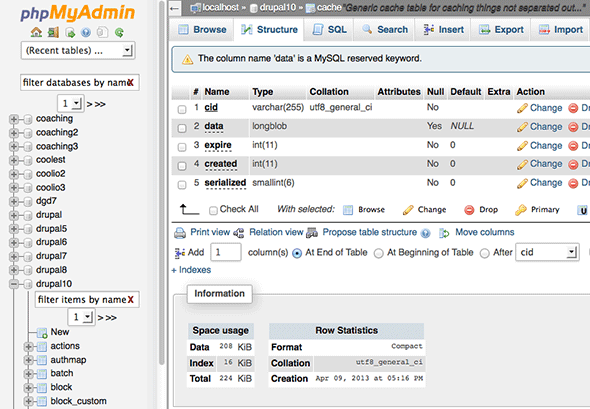Introduction
This tutorial will teach you how to perform tasks on MySQL database using web interface of PHPMyAdmin. You'll learn how to create database, table, perform sq. Since now you're all set, you can finish this part with the actual installation of phpMyAdmin: brew install phpmyadmin Nginx. Install the default Nginx with: brew install nginx Setup auto start. Since you want to use port 80 (default HTTP port), you have to run the Nginx process with root privileges. Nov 03, 2014 brew install phpmyadmin Configurations. Now, lets configure the installed components and make sure they work as expected. To make the services run at startup, provide.
PhpMyAdmin is a free and open source tool for the administration of MySQL and MariaDB. As a portable web application written in PHP, it has become one of the most popular administration tool for MySQL.
In this tutorial, we will learn the steps involved in the installation of phpMyAdmin on MacOS.
Prerequisites
- MacOS
- Login as an administrator on terminal.
- Homebrew must be installed on the system.
- PHP 5.x or greater
Installation
Installation of phpMyAdmin includes following steps
1) Download the file

To install the file on MacOS, we need to download a compressed file from the official website of phpMyAdmin https://files.phpmyadmin.net/phpMyAdmin/4.7.6/phpMyAdmin-4.7.6-all-languages.tar.gz
2) Extract the file
3) Start the development server
Brew Phpmyadmin Tutorial
To access phpMyAdmin from localhost, we need to start the development server. First, we need to change our working directory by typing the following command:
Development server will be started having the root server in the phpmyadmin directory. Now, type localhost:8080 to access phpmyadmin on localhost. It will appear like this.
Window will prompt us to fill our MySQL username and password. Fill the required details and press GO.
Now we have successfully installed phpMyAdmin on MacOS.
Keeping software updated can be very time consuming because let’s face it, software runs our lives. Unless you’ve been living in the forest the past 20 years, you use software daily. As a Developer, I use phpMyAdmin, it’s my app of choice when managing databases because it runs smoothly, and it’s free. I love free, don’t you?
Now there comes a time in a Developer’s life when he/she needs to upgrade their phpMyAdmin installation. But since it’s one of those things that isn’t entirely “urgent” for the most part, security updates aside, we tend to put off upgrading until we start to see rust (metaphorically speaking).
Automatic upgrades for phpMyAdmin
I’m going to assume you’re using a Linux/Unix server, and know how to use the command line, since that’s the way I roll. If you don’t have git installed, just type:
Now let’s grab the latest phpMyAdmin code:
This says, go into my home/workspace directory, and pull the latest version from git, but not the entire git history.
Next, let’s create a command line script to run the updates. I’m a Florida PHP Developer, so we’ll use PHP. Name the script update_phpmyadmin.php for simplicity.
Before being able to use this script, we need to make it executable; type this:
Finally, let’s schedule the task with cron so it runs automatically:
There you go, you’re automagically updating your phpMyAdmin install.

Why not use apt-get or yum or brew?
You might be asking why not just use apt-get or yum or brew (MAC) to automatically update phpMyAdmin. The answer is simple. You want the latest from phpMyAdmin, and apt-get/yum tend to fall behind. If you want the latest phpMyAdmin, use this approach.
Brew Phpmyadmin Config
Conclusion
You just learned how to get phpMyAdmin to auto update. Use with caution; not responsible if you break something. Should you need PHP Developer help, contact us for a quote.
Disclaimer
Please confirm your code works locally before pushing to a web server. Please eyeball the code before running it to confirm it will not destroy you system. Not responsible for any damages.
